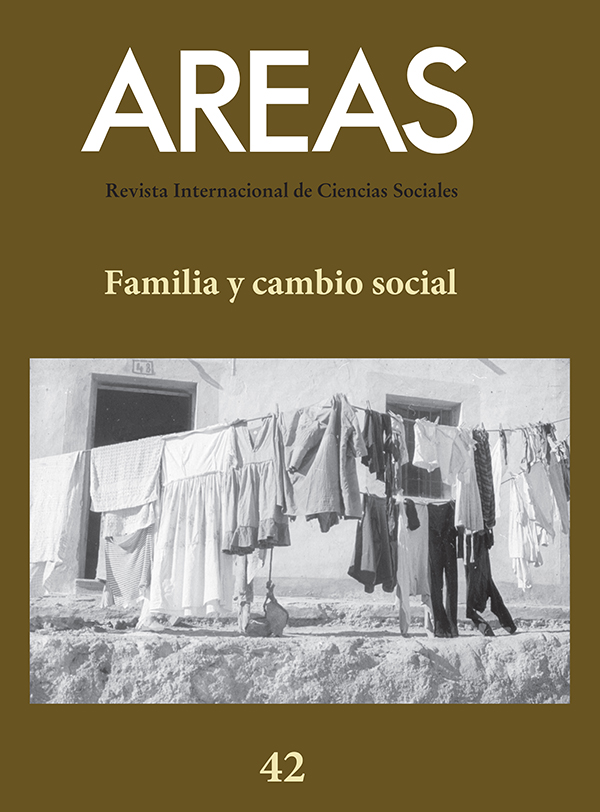EQUALITY OPPORTUNITY PLANS AS AN INSTRUMENT OF A SOCIAL CHANGE POLICY
Abstract
On many occasions, politics is intended to achieve lofty objectives of social and cultural change related to the achievement of real equality between women and men, but for this, the institutionalization of equality bodies at different levels of government and instruments is unavoidable. Those enable the actions necessary for the implementation of these policies. In this article, a content analysis of the equality plans developed in the municipalities of the Murcia Region is carried out, with the aim of knowing the impact that equality legislation has on the development of equality plans at the municipal level, as well as whether they have served as an instrument of social change policies.
Downloads
-
Abstract2229
-
PDF (Español (España))1162
-
HTML (Español (España))449
References
ALBERDI, I. y ROJAS, L. (2005): Violencia: tolerancia cero. Barcelona, Fundación “La Caixa”.
BERENI, L. y REVILLARD, A. (2011): Contentious Institutions: Rethinking the Movement/State Intersection, Paper presented at the second European Conference on Politics and Gender, Central European University, Budapest, January 13th-¬15th 2011. https://annerevillard.files.wordpress.com/2011/09/berenilrevillard2011contentious-institutions.pdf.
BUSTELO, M. (2014): “Three Decades of State Feminism and Gender Equality Policies in Multi-Governed Spain”, Sex Roles, 74 (3-4), pp. 107-120. DOI 10.1007/s11199-014-0381-9.
BUSTELO, M. y ORTBALS, C. (2007): “The Evolution of Spanish State Feminism. A Fragmented Landscape”, en J. Outshoorn y J. Kantola (eds.), Changing State Feminism. Basingstoke, Palgrave, pp. 201-223.
CLOSINGAP (2019): Coste de oportunidad de la brecha de género en la conciliación. https://closingap.com/wp-content/uploads/2020/11/Informe_-Conciliacion_compressed.pdf.
DELEGACIÓN DEL GOBIERNO CONTRALA VIOLENCIA DE GÉNERO (2020): Macroencuesta de Violencia contra la Mujer 2019. Madrid, Ministerio de Igualdad. https://violenciagenero.igualdad.gob.es/violenciaEnCifras/macroencuesta2015/Macroencuesta2019/home.htm.
DONATI, P. (1993): “Pensamiento sociológico y cambio social: Hacia una teoría relacional”, Revista Española de Investigaciones Sociológicas, 63, pp. 29-51.
EUROSTAT (2020): Salarios y costes laborales. https://ec.europa.eu/eurostat/statisticsexplained/index.php?title=Wages_and_labour_costs/es&oldid=494293.
FEDERACIÓN ESPAÑOLA DE MUNICIPIOS Y PROVINCIAS (2006): Guía para Elaborar Planes Locales de Igualdad. http://femp.femp.es/files/566-182-archivo/Guia%20elaboracion%20Planes%20Locales%20Igualdad.pdf
INE (2020): Mujeres y hombres en España. https://www.ine.es/ss/Satellite?L=es_ES&c=INESeccion_C&cid=1259925472720&p=1254735110672&pagename=ProductosYServicios%2FPYSLayout.
LAS HERAS, M. y BARRAZA, M. (2020): Mujer y Trabajo en remoto durante la Covid19. Centro Trabajo y Familia del IESE. https://mireialasheras.com/wp-content/uploads/2020/07/infografias-teletrabajo-COVID19.pdf.
LOMBARDO, E. y LEÓN, M. (2014): “Políticas de igualdad de género y sociales en España: origen, desarrollo y desmantelamiento en un contexto de crisis económica”, Investigaciones Feministas, 5, pp. 13-35.
MAZUR, A. G. (2002): Theorizing feminist policy. Oxford, Oxford University Press.
MCBRIDE, D. y MAZUR, A. (2010): The Politics of State Feminism. Innovation in Comparative Research. Philadelphia, Temple University Press.
MILLÁN, M. G.; SANTOS, M. P. y PÉREZ, L. M. (2015): “Análisis del mercado laboral femenino en España: evolución y factores socioeconómicos determinantes del empleo”, Papeles de población, 21 (84), pp. 197-225.
MINISTERIO DE LA PRESIDENCIA, RELACIONES CON LAS CORTES E IGUALDAD (2020): Mujeres víctimas mortales por violencia de género en España a manos de sus parejas o exparejas. https://violenciagenero.igualdad.gob.es/violenciaEnCifras/victimasMortales/fichaMujeres/pdf/Vmortales_2020_15_06.pdf.
MORENO, C. y GIL, S. (2018): “Las mujeres en la Guardia Civil: aspectos normativos”, Cuadernos de la Guardia Civil, 56, pp. 61-28.
ORGANIZACIÓN DE LAS NACIONES UNIDAS (1945): Carta de las Naciones Unidas. http://www.defensa.gob.es/Galerias/defensadocs/carta-ONU-1945.pdf.
DIARIO OFICIAL DE LA UNIÓN EUROPEA (2011): “Pacto Europeo por la Igualdad de Género 2011-2020”, C.155, de 25 de mayo de 2011, p. 12.
PAPÍ-GÁLVEZ, N. y CAMBRONERO-SAIZ, B. (2011): “Acciones públicas de sensibilización de género. El esfuerzo de la administración regional y local en comunicación publicitaria (1999-2007)”, Pensar la Publicidad, 5 (2), pp. 181-203.
RODRÍGUEZ LÓPEZ, M. y ROBLES ÁLVAREZ, D. (2016): “La publicidad institucional en España: análisis de las campañas contra la violencia de género del Gobierno (2006-2015)”, Revista de Comunicación Vivat Academia, 134, pp. 86-108.
SÁNCHEZ, I. C.; AVILÉS, M. y GARCÍA-ESCRIBANO, J. J. (2020): “La implantación de Planes de igualdad de Oportunidades entre Mujeres y Hombres en los municipios de la Región de Murcia (España)”, Azarbe, Revista Internacional de Trabajo Social y Bienestar, 9, pp. 83-92. https://revistas.um.es/azarbe/article/view/436001.
SÁNCHEZ, I. C.; AVILÉS, M. y GARCÍA-ESCRIBANO, J. J. (2020): Índice Sintético para la valoración de Planes de igualdad de oportunidades entre hombres y mujeres. Registro General de la Propiedad Intelectual, Ministerio de Cultura y Deporte.
UNIDAD DE MUJERES Y CIENCIA (2020): Resultados del cuestionario sobre el impacto del confinamiento en el personal investigador, UMYC del Ministerio de Ciencia e Innovación. https://www.observatorioigualdadyempleo.es/download/resultados-del-cuestionario-sobre-el-impacto-del-confinamiento-en-el-personal-investigador/.
VALIENTE, C. (2006): El feminismo de Estado en España: El Instituto de la Mujer (1983-2003). Valencia, Universitat de Vàlencia.
VALIENTE, C. (2013): “Gender equality policymaking in Spain (2008-11): Losing momentum”, en B. N. Field y A. Botti (eds.), Politics and society in contemporary Spain: From Zapatero to Rajoy. New York, Palgrave Macmillan, pp. 179-195.
The published works by this Journal are subject to the following terms:
1. The Publication Service of the University of Murcia (the Editor) owns the copyright of its publications. It promotes and allows its use under the indicated licence in Section 2.
© Servicio de Publicaciones, Universidad de Murcia, 2011
2. Papers are digitally published under the licence Creative Commons Reconocimiento-NoComercial-SinObraDerivada 3.0 España (legal text). They can be copied, used, disseminated, transferred and publically presented if: i) the author is quoted, as well as the original source of publication (Journal, editorial and URL); ii) they are not used for commercial purposes; iii) the licence of use is mentioned.
3. Auto-file Conditions. It is allowed and authors are encouraged to digitally disseminate their pre-print versions (versions prior to review) and/or post-print (reviewed version accepted for its publication) since it promotes its early diffusion and the corresponding increase of quotes and scope within the academic community. RoMEO Colour: green.


